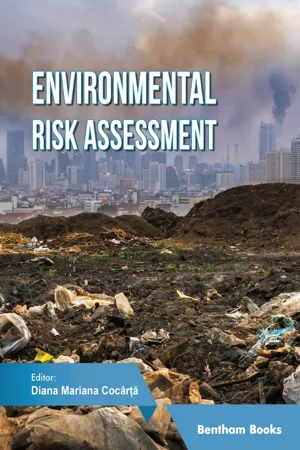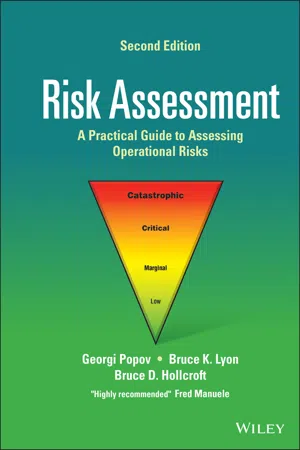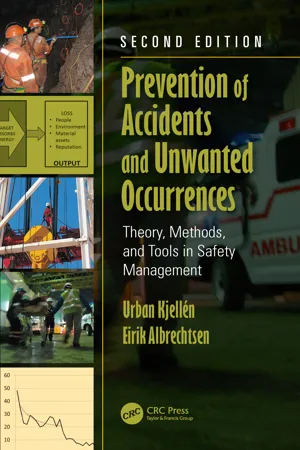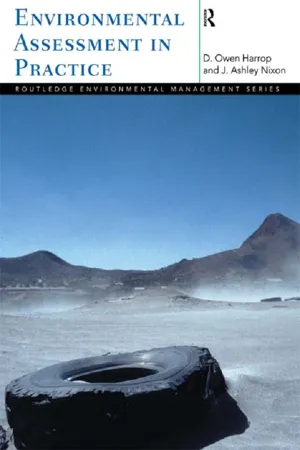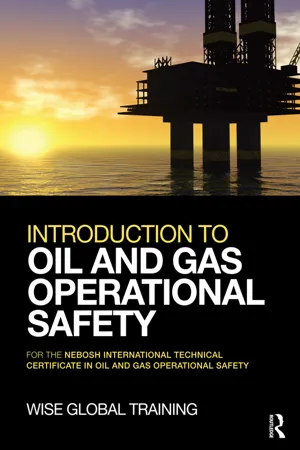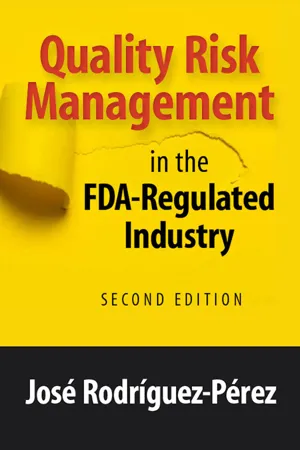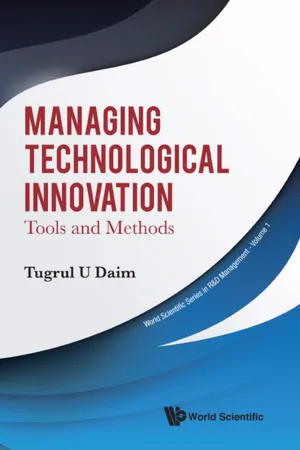Technology & Engineering
Risk Assessment
Risk assessment involves identifying, analyzing, and evaluating potential risks associated with a technology or engineering project. It aims to determine the likelihood and impact of these risks and develop strategies to mitigate or manage them effectively. By conducting risk assessments, organizations can make informed decisions to minimize potential negative outcomes and enhance project success.
Written by Perlego with AI-assistance
Related key terms
11 Key excerpts on "Risk Assessment"
- eBook - ePub
- Diana Mariana Cocârță(Author)
- 2000(Publication Date)
- Bentham Science Publishers(Publisher)
Aside from that, various countries have developed their own environmental Risk Assessment software, which has successfully integrated human health Risk Assessment into the system. Programs can integrate and output information based on the information provided in the data input. Ecological Risk Assessment has recently been used in the study of genetically modified organisms, generating useful results [ 2 ]. i. What is Risk? According to the Oxford Dictionary, the risk is defined as “an event/situation that involves exposure to danger,” and it is also used to describe what is likely to happen (in the future) if the required preventive measures are not carried out in accordance with the standards. In other words, risk was defined by the Royal Society in 1992 as “the combination of the probability or frequency of occurrence of a defined hazard and the magnitude of the consequence of the occurrence” [ 3 ]. However, there are situations when the danger cannot be predicted or may have a small percentage of circumstance. Herein, the Risk Assessment study is performed to identify the risk and propose solutions for its elimination. The Risk Assessment mechanism is applied in a wide range of domains and academic disciplines. Engineers, for example, use the Risk Assessment study process to determine the likelihood and effects of component failure while designing a bridge [ 4 ]. Engineers were primarily involved in the construction of churches during the Romanesque to Gothic transition stage. Many structures collapsed, and deaths and environmental damage occurred during that time. These events aided society in evolving over the centuries and implementing efficient techniques to reduce the risks of collapses and loss of life. To avoid negative events, engineers and organizations now conduct rigorous Risk Assessments - eBook - ePub
Risk Assessment
A Practical Guide to Assessing Operational Risks
- Georgi Popov, Bruce K. Lyon, Bruce D. Hollcroft(Authors)
- 2021(Publication Date)
- Wiley(Publisher)
In fact, Risk Assessments are a common practice in Europe, Australia, New Zealand, Canada, and other parts of the world. In the United Kingdom, Risk Assessments have been legally required since 1999 by the Health and Safety Executive (HS&E). As previously stated, the United States is behind other parts of the world in the use of Risk Assessment; however, there is momentum being generated by recent standards, risk‐centric organizations, and their leaders.3.2 Risk Assessment Within the Risk Management Process
A central theme in this text is the concept of assessing risk within the principles, framework, and process of risk management. According to the American National Standard Institute’s ANSI/ASSP/ISO 31000 risk management standard, risk management is defined as “coordinated activities to direct and control an organization with regard to risk.” In a way, it is the process of making management decisions based on known risks and the organization’s acceptance of those risks.The term “Risk Assessment” is often misused. It’s the authors’ experience that some organizations (and even some safety professionals) refer to hazard inspections, analyses, surveys, and compliance audits as “Risk Assessments.” Thus, a clear understanding of the term is necessary. ANSI/ASSP/ISO 31000 states there are three distinct sequential components to the act of “Risk Assessment” which are:- Risk Identification – finding, recognizing, and recording hazards.
- Risk Analysis – understanding consequences and probabilities and existing controls.
- Risk Evaluation – comparing levels of risk and considering additional controls.
Consequences are the potential outcomes of an undesirable event which is measured by severity. Probability or likelihood is an estimation of the chances of the undesirable event occurring over a unit of time or for a specific activity. Risk Assessment is an attempt to “predict” the worst event that could reasonably happen as a result of the hazard or operation, and how likely it is to occur. This estimation is often qualitative in nature; however, some are semiquantitative or quantitative based. It is important to remember that the risk level relates to uncertainty and its effect on an organization’s ability to achieve its objectives. - eBook - ePub
Managing Technology and Product Development Programmes
A Framework for Success
- Peter Flinn(Author)
- 2019(Publication Date)
- Wiley(Publisher)
7 Identifying and Managing Engineering Risks7.1 Introduction
Chapters 2 and 6 drew attention to two fundamental, and sometimes opposing, aspects of product and technology development work:- The creative element of the process, developing new ideas to solve problems and to improve people's well‐being.
- The element of risk which those new engineering solutions might introduce in terms of reliability, robustness, or creation of other forms of harm or danger.
This chapter is concerned with the second of these points – the identification of risks that require attention. Chapter 8 then deals with how those risks might be reduced or eliminated through engineering development work.Risk is a widely used term, and its simplest definition is perhaps given by the Cambridge English Dictionary: ‘the possibility of something bad happening’. Within the engineering and technology community, it is essentially ‘the possibility of something going wrong’. A more technical description can be found in the Risk Management Guide for DoD Acquisition: ‘Risk is a measure of the potential inability to achieve overall program objectives within defined cost, schedule, and technical constraints’. Risk in this context is normally considered to have two elements: the frequency of a potentially hazardous event and the severity of its consequences.It should be noted that the concern in this book is with engineering or technical risks that can be addressed through the engineering development process. Other forms of risk, such as business or financial risks, are not covered here, although the same principles can be used for their management – see Refs. 1 –3 .7.2 Identification of Risks
It might be argued that the separate identification of risks is a relatively new concept in the engineering world. Engineers have, over a 200‐ to 250‐year period, always performed experiments and calculations to ensure that their products will work. Initially, knowledge was limited and failure was commonplace despite engineers' best efforts. For example, nineteenth‐century railways were plagued with problems and several royal commissions were set up in the United Kingdom looking, for example, at iron bridges on railways (1847). Unlike today, that was a period when failure in service was commonplace and was one of the primary learning mechanisms – an approach that would be unacceptable nowadays. - eBook - ePub
- Maria Chiara Leva, Tom Kontogiannis, Marko Gerbec, Olga Aneziris(Authors)
- 2019(Publication Date)
- Routledge(Publisher)
2 Understanding hazards and risksPassage contains an image
From the basics to new frontiers Micaela Demichela and Gabriele Baldissone3 Process Risk AssessmentIntroduction
Process Risk Assessment is nowadays a mature discipline that is based on consolidated techniques and tools for each phase of its cycle. The definition of “risk” and the methodologies falling under the acronym PRA – Probabilistic Risk Assessment – have arisen from the nuclear domain and laid the foundations of technological risk evaluation (Rasmussen 1975).Technological risk refers to the undesired consequence of a particular hazardous activity in relation to its likelihood of occurrence . This clearly means that the risk (R ) can be seen as the product of two parameters: F , the expected probability that a hazardous event could occur within a given time interval; and M , the severity of the consequences ensued (Magnitude).From the Rasmussen’s Report the logical link between the two is set to:R = F · MThis simple definition of technological risk allows safety analysts to assess risks and make comparisons between the foreseeable risks associated to a given process or plant or to examine whether risks fall within particular tolerability limits.Since process plants are usually complex socio-technical systems, the Risk Assessment process requires a procedure to control this complexity and to support risk-based decision making within the Total Safety Management framework (see Chapter 1 ).The Risk Assessment procedure
As discussed in Chapter 1 , standard ISO 31000:2009 defined a framework for Risk Assessment that is coherent with most process Risk Assessments from early days, although with some variations. According to Figure 3.1 - eBook - ePub
Prevention of Accidents and Unwanted Occurrences
Theory, Methods, and Tools in Safety Management, Second Edition
- Urban Kjellen, Eirik Albrechtsen(Authors)
- 2017(Publication Date)
- CRC Press(Publisher)
In practice and in daily language, the notion of risk is often mixed with the notion of hazard. Here, we define hazard as a source of energy that can lead to injury to personnel or damage to the environment or material assets. Risk is an expression of the likelihood and consequences of future losses due to a release of hazards.20.2 The Risk Assessment processAccidents and near accidents are unwanted events occurring at random points in time. They also represent opportunities to learn about hazards and causal factors at the workplace and within a company. We should take advantage of these opportunities when they occur and conduct adequate investigations. Workplace inspections and safety audits are pre-planned activities that also represent opportunities for learning. Their initial focus is on deviations, contributing factors, and root causes and not on hazards.Risk Assessment is complementary to these different activities. It is a planned activity in which we want to identify and remedy hazards before accidents and near accidents happen. Risk Assessment is thus anticipatory in nature and supports feed-forward processes rather than the feedback processes of, for example, accident investigations. By applying Risk Assessment, we will speed up the learning process.Risk Assessment involves the following activities (ISO 2009 ; Rausand 2011 ):- Establishing the context. Defining the analysis object and determining its limits. The analysis object can be a geographical area of a plant, a machine, a job, and so on. Planning is another important part of this initial activity; become familiar with the object, establish risk acceptance criteria, establish the analysis team, make a time schedule, collect background information, and so on.
- Identification of hazards and unwanted occurrences where people, the environment, or material assets may come into contact with a hazard.
- Risk analysis
- eBook - ePub
- Owen Harrop, Ashley Nixon(Authors)
- 2005(Publication Date)
- Routledge(Publisher)
Chapter 4
Environmental Risk Assessment
IntroductionTerminologyApplications of Risk AssessmentQuestions for thoughtIntroduction
Public concerns and anxieties have focused attention on the need for informed and transparent assessment procedures to ensure that the impact of developments is acceptable from an environmental perspective. Therefore, it is essential that due attention is given to environmental Risk Assessment procedures as well as EA for certain projects. Risk Assessment is widely regarded as a specialised tool for high-profile or high-risk projects that require an examination of potential risk extending beyond a conventional source–pathway–receptor analysis. Recent guidance has been issued by the UK Department of Environment on Risk Assessment procedures for environmental protection (Department of the Environment UK 1995). The output of Risk Assessment and EA studies has become inextricably linked with the common objective of assessing the significance of impact. A growing number of practitioners are incorporating the procedures of Risk Assessment into EA studies.Risk combines the probability of an adverse event (a hazard) occurring, with an analysis of the severity of the subsequent consequences. ‘Risk Assessment’ can be simply defined as the process of assimilating and analysing all the available scientific information associated with a hazard or set of hazards (Rodricks 1992a). Pollard et al. (1995) have previously discussed a number of approaches to Risk Assessment applied within environmental management and these can be considered in a general sense as being qualitative, semi-quantitative or quantitative in nature.Environmental risks will always be a contingent of the variable conditions of exposure and, under a range of exposure scenario conditions, risk can be envisaged as a distribution of risks ranging from low to high-risk conditions. High-risk situations are those where direct short exposure pathways exist from a high hazard source to a particularly sensitive receptor; whereas low-risk situations are those where indirect or diffuse pathways exist from a source of low hazard to a receptor of low sensitivity, or where substantial dilution occurs along the exposure pathway (Pollard et al - eBook - ePub
- Martin Muckett, Andrew Furness(Authors)
- 2007(Publication Date)
- Routledge(Publisher)
The same can be said for Risk Assessment, in so far as while assessments are required by law, the moral argument for reducing personal injuries and incidents of ill health by the use of risk control measures should also not be overlooked. The financial and economical implications of failing to identify risks generally, particularly those related to fire safety, can also have serious implications on an organisation’s ability to fulfil its contractual obligations, maintain its position in the market, protect its reputation and potentially, and secure its survival.Figure 5.1 In order to assess risks from fire it is necessary to understand the general principles and practice of conducting Risk AssessmentsThe Risk Assessment process will vary depending upon an organisation’s activities. It may be that the assessment will be a highly technical and complex scientific analysis, such as in the case of COMAH site activities (a site defined under the Control of Major Accident Hazards Regulations 1999). At the other end of the scale, the assessment may simply be a fairly succinct analysis of the hazards, risks and control measures relating to the work activities conducted in a small office environment.5.2 Definitions Relating to Risk AssessmentThe first chapter of this book included basic definitions relating to the management of safety. There is a wide range and some diversity of terminology contained within British and European standards and HSE and industry guidance. The following definitions, drawn from the standards and guidance, are used in this book.5.2.1 HazardSomething with the potential to cause harm. A source or situation that could cause harm such as chemicals, electricity, working at height, hot work processes and in the case of an emergency an inability to respond and escape to a place of safety. - eBook - ePub
- John McManus(Author)
- 2012(Publication Date)
- Routledge(Publisher)
According to Karl Wiegers the skilful project manager will use risk management as a technique for raising the awareness of conditions that could cause the project to fail. For example, consider a project that begins with an unclear product vision and a lack of customer involvement. The astute project manager will spot this situation as posing potential risks, and will undertake an assessment of them. At the requirements stage the impact of this situation may not be too severe. However, if time continues to pass and the lack of product vision and customer involvement are not improved, the potential threat to the project will steadily rise and jeopardize the whole project. Under such circumstances assessment is paramount to success.3.3 Approach to assessment
From our previous discussions in Chapters 1 and 2 we defined risk as three broad categories:1 Category business risk: whatever affects your ability to meet project objectives. These risks are managed by the business and cannot be transferred. 2 Category technical risk: includes full SDLC project risk; these are managed by the party best placed to do so. Project personnel and stakeholders share detailed plans for managing risks.3 Category external risk: outside the control of the project, such as legislation, changes in provider marketplace. Project personnel and stakeholders produce and maintain plans for mitigating these risks.Through the preparation of risk statements (and supporting information), and perhaps the use of qualitative techniques we will have ascertained some view as to what our exposure to risk represents. Risk exposure helps us to list the risks in priority order, with the risks of most concern given the highest priority. The key activities associated with undertaking a Risk Assessment are listed below: - eBook - ePub
Introduction to Oil and Gas Operational Safety
for the NEBOSH International Technical Certificate in Oil and Gas Operational Safety
- Wise Global Training Ltd(Author)
- 2014(Publication Date)
- Routledge(Publisher)
To put in place risk control measures it is important to identify those risks, the first step of which is to perform a Risk Assessment. This allows those risks which are relevant to be identified and be given appropriate consideration. In the oil and gas industry, those risks are generally associated with all plant, equipment, products, processes and systems of work, all of which have the potential to cause harm.There are a number of techniques available when assessing risks, including:► The 5-step approach► Qualitative assessment techniques► Semi-quantitative assessment techniques► Quantitative assessment techniquesWe shall be looking at each of these in more detail as we progress. However, let’s just remind ourselves of what a hazard and risk are.A hazard is defined as something with the potential to cause:► Harm including ill health and injury► Damage to property, plant, products or the environment► Production losses or increased liabilitiesA risk is defined as the likelihood that the harm will occur: the chance – high or low – that somebody could be harmed or some infrastructure could be damaged. This is usually accompanied by an indication of how serious the harm could be.Now we need to look at the four general Risk Assessment techniques we just mentioned.3.1.3The 5-step approach to Risk AssessmentStep 1Identify the hazardsStep 2Decide who might be harmed and howStep 3Evaluate the risks and decide on precautionsStep 4Record the findings and implement themLet’s look at each of these steps in more detail to understand what they mean in practice.Step 5Review the assessment on a regular basis and update if necessaryThe 5-step approach – step 1: identify the hazards
The first step is to work out how people could be harmed. In order to help identify the hazards the following procedure should be followed:► Conduct a tour of the workplace and observe what could reasonably be expected to cause harm.► Consult the workers or their representatives for their views and opinions.► - José Rodríguez-Pérez(Author)
- 2017(Publication Date)
- ASQ Quality Press(Publisher)
Life cycle phases have different needs and require different techniques. For example, during the concept and definition phase, when an opportunity is identified, Risk Assessment may be used to decide whether to proceed or not. Where several options are available, Risk Assessment can be used to evaluate alternative concepts to help decide which provides the best balance of risks. During the design and development phase, Risk Assessment contributes to ensuring that system risks are tolerable and to identifying risks impacting subsequent life cycle phases.6.3 Risk Assessment Techniques and Tools 6.3.1 Basic Risk Management Facilitation Methods Some of the simple techniques that are commonly used to structure risk management (Tague 2005) by organizing data and facilitating decision making are discussed following.Flowcharts/Process Mapping. A flowchart is a picture that describes the steps of a process in sequential order. It is useful when trying to understand how a process is really being done. Unfortunately, many companies do not have flowcharts of their processes. When trying to solve a problem, it is a good idea to spend some time walking through the process and comparing how things are actually done (the real process) with how they should be done (the theoretical process required by applicable working instructions).Flowcharts are easy-to-understand diagrams showing how steps in a process fit together. This makes them useful tools for communicating how processes work and for clearly documenting how a particular job is done. Furthermore, the act of mapping a process in flowchart format helps you clarify your understanding of the process and helps you think about where the process can be improved.Flowcharts are simple diagrams that map out a process so that it can easily be communicated to other people. To draw a flowchart, brainstorm the tasks and decisions made during a process and write them down in order. Then map these out in flowchart format using appropriate symbols for the start and end of the process, for actions to be taken, and for decisions to be made. Finally, challenge your flowchart to make sure that it’s an accurate representation of the process and that it represents the most efficient way of doing the job. This tool must be the first step in any Risk Assessment methodology.- eBook - ePub
Managing Technological Innovation: Tools And Methods
Tools and Methods
- Tugrul U Daim(Author)
- 2017(Publication Date)
- WSPC(Publisher)
The overall risk management process can be divided into two broad phases — risk analysis and risk management (Chapman, 2001). Risk analysis comprises on identifying, assessing, and analyzing the risks for their criticality, while risk management is concerned with the actual progress of the risk management strategy (Chapman, 2001). These include the risk management strategy, monitoring the status of risk mitigation, and overall improvement of the strategy based on feedbacks and evaluations. Since the basic objective of this research concerns identification and assessing the risks associated with a DT development process, the portion on risk management will not be discussed as it falls beyond the boundaries of the present research. The identification and analysis of the risks often pave the way for an effective risk mitigation strategy. Risk identification can be defined as “discovering, defining, describing, documenting and communicating risks before they become problems and adversely affect a project” (Barati and Mohammadi, 2008). A proper risk identification process ensures the identification of the widest range of risks associated with the project (Barati and Mohammadi, 2008; Kasaap and Kaymak, 2007) and its output is a list of possible risks associated with the various process stages of a project (Cooper et al., 2004). Once the risks are identified, they are appropriately treated depending on the nature of the project. In the case of a simple or streamlined technology/engineering project with little uncertainty (and therefore few risks), the risks may be kept simply as a list of red flagged items (USDOT, 2006). However, for complex and highly uncertain project like developing a DT, a proper identification of the risks can serve as a very important tool for analysis, mitigation, and planning for the risks associated with the project. There is no single “best method” to identify the risks associated with a project or a technology development process
Index pages curate the most relevant extracts from our library of academic textbooks. They’ve been created using an in-house natural language model (NLM), each adding context and meaning to key research topics.
